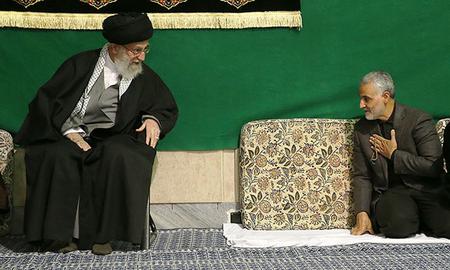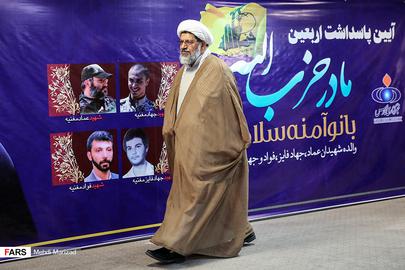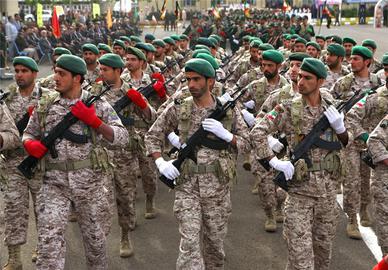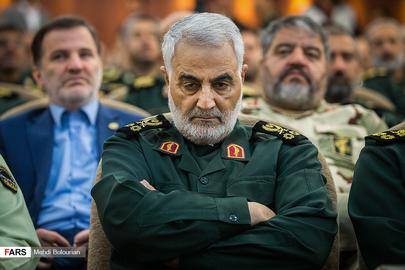The Revolutionary Guards: An Introduction
The Islamic Revolutionary Guard Corps (IRGC) is the Islamic Republic of Iran’s most important institution. The military-security institution commands huge influence in every aspect of Iranian public life, from culture and the environment to the economy, politics and judicial process. Whatever the field or area, the IRGC is not required to report to anybody and is answerable to no one.
The IRGC was created early after the 1979 Islamic Revolution by the order of the founder of the Islamic Republic, Ayatollah Ruhollah Khomeini. Its declared mission was to safeguard the revolution and its accomplishments. As the years have gone by, it has expanded its sphere of activities. The entities under its control have multiplied to such a degree that it now operates effectively as a parallel government. It interferes in all current affairs of the country and it aims to have control over every aspect of the way Iran is run.
In a series of reports, IranWire presents a detailed portrait of this powerful and mysterious institution and, for the first time, identifies and explains all bodies, institutions and other entities operating under the umbrella of the Revolutionary Guards, at the same time outlining its activities through an infographic and an interactive diagram.
The infographic is a visual representation of the Guards’ organizational structure and presents all institutions under the control of IRGC in one map. It resembles a family tree, a portrait of the IRGC with all its children, grandchildren and great-grandchildren — a dramatic picture of power in Iran today.
In the interactive diagram, the viewer is able to use the mouse to see how various entities under the control of the Guards emerged, and how they are connected — exactly like a family tree.
IranWire has aimed for this series and the overall project to be informative and a solid research tool. But it is not perfect, and there will always be room for updates, enhancements and further information. We welcome your views, ideas and knowledge, so please do get in touch via email, Twitter or Facebook.
***
The IRGC Quds Force (Nirooy-e Quds-e Sepah)
The roots of the IRGC Quds Force date back to the early days after the 1979 Islamic Revolution and can be found in the Liberation Movements Unit (Vahed-e Nehzathay-e Azadi Bakhsh). On June 15, 1982, the unit hosted an international event in Tehran inviting various active militia groups from the Middle East and northern Africa. In the final resolution of the event, the participants asked the Islamic Republic of Iran to “form a Quds Force.” On the same day, the public relations office of the Qom Seminary, the most important Shia seminary in Iran, issued a statement and asked for volunteers to “register for deployment to Syria and Lebanon.”
The infighting by different factions within the IRGC led to the transfer of the Liberation Movements Unit to Iran’s Ministry of Foreign Affairs. Javad Mansouri, a former commander-in-chief of the IRGC has said that “the Liberation Movements Unit stayed in the Foreign Ministry for a few years, but it then moved back to the IRGC and turned into the Quds Force.”
From the very beginning, the Quds Force identified itself as an anti-Israel force and stated “helping Palestine” and “reclaiming Jerusalem” as its mission. But it also developed a wider mission that included exporting the Islamic Revolution, supporting groups (mainly Shia) in the Middle East and organizing them under the aegis of the “Liberation Movement,” and sending military units and paramilitary groups to countries like Lebanon, Syria and Afghanistan. The Islamic Republic either had strategic interests or was planning a foothold in these countries.
The Quds Force served an important objective during the Iran-Iraq War (1980-88). Iran wanted to take advantage of the Shia and Kurdish opposition to Saddam Hussein’s regime, as well as use Iraqi prisoners of war in its war with Iraq. The Iraqi opposition formed the Badr Brigade in 1982. The name of the brigade refers to the Battle of Badr led by Prophet Muhammad in 624. Badr Brigade included two units. The Ahrar Unit comprised Iraqi prisoners of war and the Iraqi Shias opposing Saddam Hussein formed the Mujaheddin Unit. The Badr Brigade worked closely with the Quds Force to create the Ramadan Headquarters. The commanders of Ramadan Center led reconnaissance missions and organized operations within the territory of Iraq. The Ramadan Center also created an axis between the Kurds in the north of Iraq and Shias in the south and helped to fight Saddam Hussein.
The formation of the Quds Force is also traced back to the overseas activities of the IRGC forces which were dispatched by the government of the Islamic Republic. These forces played a crucial role in creating Hezbollah in Lebanon in 1985. At the time Lebanon was going through a civil war and the Israeli forces had occupied part of the country. With the full backing of the leader of the Revolution, Ayatollah Ruhollah Khomeini, and close supervision by Ali Akbar Mohtashami, an acolyte of Khomeini who was then Iran’s ambassador to Syria, these forces were able to mobilize a number of Shia militias and form Hezbollah (Party of Allah) in Lebanon’s Bekaa Valley.
After the end of the war with Iraq in 1988, the Quds Force began to expand its operations in other countries, including in former Yugoslavia in the early 1990s. The Quds Force, along with Hezbollah, actively supported Bosnian Muslims in the Bosnian war. In addition to training Bosnian soldiers, the Quds Force sent arms to the Bosnian forces and provided them with military knowledge. During the same period after the First Gulf War, the Quds Force backed the Patriotic Union of Kurdistan (PUK) and its leader Jalal Talebani in its fight against Saddam Hussein. It also helped the PUK to administer Iraqi Kurdistan jointly with the Kurdish Democratic Party (KDP). The support given by the Quds Force to Talibani increased the PUK’s presence in Iraq in future years.
After the expansion of the Quds Force to more countries in the Middle East, it turned into a powerful diplomatic force in the region. This power even incensed some Iranian officials. Akbar Hashemi-Rafsanjani, who was the Iranian president from 1989 to 1997, later told the author of his biography that the Foreign Affairs Ministry was being crippled in carrying out its duties in the most important areas, as it wasn’t able to appoint any ambassadors in countries like Iraq, Syria, Lebanon, Afghanistan, and Yemen without the approval of the Quds Force.
There are reports that members of the Quds Force have used its feared reputation to fill their own pockets, or to commit illegal acts such as money laundering, forgery and trafficking arms, narcotics and drugs. According to media reports that came out after the Bosnian War the Quds Force was involved in smuggling weapons during the war. The Quds Force has denied all accusations, but different cases against the force in various African countries, such as Nigeria, Kenya, Sudan and Senegal, proves that the Quds Force has created a weapon smuggling network.
In December 2008 in Iraq, Nader Qorbani, a Quds Force officer was arrested and charged with weapons smuggling. Two months later, five other Quds Force officers were arrested under similar charges.
In July 2009, the United States put Abu Mahdi al-Muhandis on the sanctions list and highlighted that “he ran a weapons smuggling network that moved sniper rifles through the Iran-Iraq border to Shia militias that targeted Coalition Forces.” al-Muhandis is a close associate of Ghasem Soleimani, the commander of the Quds Force and the commander of the Popular Mobilization Force (Hashd Al-Shabi), which works closely with the Quds Force. In April 2010, in another instance, Mansur Ben-Rajab, the minister advisor in Bahrain, was prosecuted on charges of money laundering and weapons smuggling. According to the case, one of his major business partners was the Quds Force. In 2011, Shin Bet (The Israel Security Agency) informed the media of the Quds Corps’ plot to smuggle weapons through Egypt for Palestinian groups like Hamas and Palestinian Islamic Jihad.
At present, the most significant and effective Quds Force weapons smuggling network is believed to take place in Yemen, where the Force is arming the Houthi militia with missiles and drones. According to different sources, the transfer of weapons takes place using ships to deliver supplies either directly to Yemen or via Somalia, bypassing the Saudi Arabia-led coalition’s efforts to intercept shipments.
In addition to weapons, in January 2012, the United States Department of the Treasury issued a statement regarding one of the IRGC commanders, Qolam-Reza Baghbani, and included him on the sanctions list for his involvement in the trafficking of narcotics and drugs. According to the Treasury’s report, “General Baghbani allowed Afghan narcotics traffickers to smuggle opiates through Iran in return for assistance. For example, Afghan narcotics traffickers moved weapons to the Taliban on behalf of Baghbani. In return, General Baghbani has helped facilitate the smuggling of heroin precursor chemicals through the Iranian border. He also helped facilitate shipments of opium into Iran.”
Furthermore, there are more reports incriminating the Quds Force in drug smuggling plots in other countries such as Turkey, Azerbaijan, Italy and Venezuela. In all the reports, the Quds Force has been in close cooperation with Hezbollah. Reports regarding Project Cassandra, which is an effort led by the United States Drug Enforcement Administration (DEA) to undercut Hezbollah funding from illicit drug sources, indicate that Hezbollah and the Quds Force have smuggled drugs and weapons across north Africa.
Forging foreign currencies is another crime associated with the Quds Force. Last year, the US government stated that an underground active network in Yemen, run by the Quds Force, was forging and distributing counterfeit notes in the country. The network’s head was Mahmoud Seif, who is now on the US sanctions list. In 2011, Seif was also charged with trafficking firearms in eastern Europe.
The Quds Force has also been accused of assassinating the regime’s dissidents. The individuals on the assassination list vary from Iraqi fighter-jet pilots who fought during the Iran-Iraq War to Iranian political dissidents in different countries. In 2011, Mansur Arbab-Sayar, an Iranian citizen, was arrested in the US charged with plotting the assassination of Saudi Arabia’s ambassador. US officials said that Arbab-Sayar worked with a Quds Force commander named Gholam Shakuri. Arbab-Sayar also confessed that he was in contact with and receiving help from Mexican drug cartels. Iran denies any involvement in the assassination plot. Some experts have doubted the claims and have mentioned that the plan was not in line with the Quds Force’s modus operandi.
Different governments in the Middle East have accused the Quds Force of involvement in espionage. During the last decade, there have been security and criminal cases against Quds Force officers in Bahrain, Saudi Arabia and Kuwait.
One of the more transparent operations of the Quds Force is founding political groups and parties in other countries and turning them into major players in the politics of that country. Hezbollah in Lebanon and the Popular Mobilization Forces (Hashd al-Shabi) in Iraq are two examples of attempts by the Quds Force to create indigenous groups in order to have powerful leverage inside Lebanon and Iraq.
To plan and execute its operations, the Quds Force benefits from other public and private organizations in Iran. For example, the commercial airline Mahan Air is used for the transit of firearms, the Red Crescent is used for undercover operations dressed up as relief activities, the Defense Ministry is used for weapons smuggling and supplies and the Reconstruction Organization of Holy Shrines in Iraq is used for other undercover operations dressed up as construction projects. The Quds Force has created a powerful network within the country and the region by connecting these various organizations.
The total number of Quds Force members, according to western media outlets, is estimated to be somewhere between 10,000 to 15,000, but these numbers are impossible to confirm. According to a report by The New Yorker, the Quds Force orchestrated more than 30 operations across the globe, from the Middle East to Thailand and Nairobi, between 2011 and 2013.
The major militia groups controlled by the Quds Force outside Iran are: The Popular Mobilization Forces (Shahd Al-Shabi) in Iraq, the National Defense Forces (NDF) in Syria, Hezbollah in Lebanon, Islamic Jihadi Movement in Palestine, and Houthi forces in Yemen. The Quds Force has also established and managed Liwa Fatemiyun, which is a militia consisting of Shia Afghan fighters, and Zeinabiyun, which consists of Shia Pakistani fighters who fight in Syria.
Quds Force Chief Commander
The chief commander of the Quds Force is appointed by the Supreme Leader Ayatollah Ali Khamenei, with a recommendation from the chief commander of the IRGC. Ahmad Vahidi held this position from the start until 2000, and since September 2000, it has been held by Ghasem Soleimani. Soleimani came to the spotlight through the United States Intelligence cables in the aftermath of the 2003 US invasion of Iraq. In order to prevent the United States’ potential attack against Iran from neighboring Iraq, Soleimani appeared to encourage a multitude of proxies in the form of militias (mainly Shia) to attack the US-led coalition force. These included the onetime militia of the Iraqi Supreme Council, Badr Corps, Moqtada al-Sadr, Mahdi Army and newly shaped militias, like Asaib Ahl al-Haq led by Qais al-Khazaili, and Katib al-Hezbollah, led by Abu Mahdi al-Muhandis.
According to the United States Central Command in 2008, Soleimani sent a message to General David Petraeus, saying that he controlled, “the policy of Iran with respect to Iraq, Lebanon, Afghanistan and Iraq.” Surprisingly, in April 2008 the Christian Science Monitor reported that Soleimani brokered a deal with Iraqi politicians, including then President Jalal Talebani, which led to the ceasefire between the Mahdi Army militants and government forces in Sadr City. News about Soleimani re-surfaced again following ISIL’s occupation of a swath of territories in Iraq in 2014. Soleimani is said to play a leading role in recruiting the former Shia militias into some of the main forces within the Hashd al-Shabi - Iraqi popular mobilization forces - to fight against Daesh (ISIL) and recapture lost territories in Iraq.
Ghasem Soleimani’s activities also extend to Syria. Here, Soleimani aided Assad’s grip on power by enabling the Syrian army to regain control in rebel-held areas run by Sunni jihadist groups and ISIL. He was in charge of coordinating the operations of the Quds Force brigades, Syrian military and security forces and Hezbollah forces alongside the Russian air campaign to capture the rebel-held areas, particularly in the 2016 campaign on Aleppo. Apart from his role in organizing military campaigns against opposition forces and Daesh, Soleimani is believed to be in charge of helping Hezbollah militias and the IRGC forces set up military bases inside Syria and Lebanon to counter Israel.
Quds Force Divisions
As subunits of the commanding headquarters, there is a deputy commander, as well as the following divisions: cultural, coordinator, intelligence, and human resources. Since all Quds Force operations are classified, it is impossible for outside researchers to determine all its active divisions. According to Anthony Cordesman, an expert in military and strategic studies, the Quds Force also has the following directorates based in its overseas operations in various countries: Iraq, Lebanon, Palestine and Jordan, Afghanistan, Pakistan and India, Turkey and the Arabian Peninsula, Asian countries of the former Soviet Union, Western nations (Europe and North America), and North Africa (Egypt, Tunisia, Algeria, Sudan and Morocco).
The Supreme Leader’s Representative in the Quds Force
The Supreme Leader’s representative in the Quds Force is appointed by the Supreme Leader’s representative in the IRGC. The office was held by Hojat-al-Islam Ismael Sa’adatnejad until 2011, and has been held by Hojat-al-Islam Ali Shirazi since then.
Unit 400
Special Operations Unit 400 is the most famous unit of the Quds Force and is tasked with the important extraterritorial operations of the Force. According to the media, most of these operations include bombings or are terrorism-related. According to Western media, the unit was established in 2012 following Ayatollah Khamenei’s call to retaliate against the US and its allies for supporting the overthrow of Bashar Assad in Syria.
The Commander in Chief of the Armed Forces
The Chief Commander of the IRGC
The Supreme Leader’s Representative in the IRGC
The IRGC Security and Intelligence Agencies
The IRGC's Social, Cultural, Scientific and Educational Institutions
The IRGC Commercial and Financial Institutions-(Khatam-al-Anbiya Construction Headquarters)
The IRGC Commercial and Financial Institutions-(Bonyad-e Ta’avon-e Sepah)
The Organization for the Mobilization of the Oppressed
The Basij Cooperative Foundation
Cyberspace Institutions and The Physical Training Organization of the Basij
Basij Headquarters and Military Organizations
Basij Social and Cultural Organizations
The Islamic Revolutionary Guards Corps: Structure and Missions
visit the accountability section
In this section of Iran Wire, you can contact the officials and launch your campaign for various problems




























comments